
The Welney Website
Welney Wash Road flooding 2006-7
report & comments
Report first posted Feb 2007, page amended/updated
Friday, 16 November 2012

|
Webmaster This is a long page containing a representative sample of reports comments and letters from businesses, residents, historians, Welney Parish Council, the Environment Agency (EA) and others with an interest. The views expressed are similar to those made many times before - and since. At the bottom right are links to other pages connected with flooding and drainage. |
Water depth varied, but was often several feet. This caused havoc to local businesses and residents, and meant long diversions for motorists, the postman, delivery drivers and through traffic. The detours, either via the A142 to the south at Mepal or the A1122 to the north at Downham Market, can add 20 miles to a journey. Children were unable to get to the village school, and local businesses lost considerable trade.
The washes were of course designed to be a holding area for excessive rainwater draining down the Great Ouse from Bedford before being discharged into the sea, but Met Office records show that rainfall was not exceptional during this period.
The two photos on the right were taken by Welney resident Mark Farrow on 2nd December 2006. Sadly, the scene remained pretty much the same for more than nine weeks. The red sign urges drivers to check the depth of water on the gauges - but they are way beyond the speed de-restriction signs and a car would probably be flooded before getting to them.
And yes, the barrier is on the wrong side of the road, and facing the wrong way.
The EA's "Flood Line" recorded announcement at 9am on Friday 26th Jan informed us that the water depth on the Wash Road was 500mm (20 inches). By 3pm on Tuesday 30th it was reported that the Wash Road was dry and that the two Highway Authorities had been advised to remove signs. Norfolk acted quickly, but not so Cambridgeshire Highways - at 1pm on Wed 31st Jan, the large signs on the A10 at Ely still showed flooding and diversions!!!
The webmaster was probably just one of hundreds who took heed of that sign and made an unnecessary detour.
| You may need to "refresh" your page to view the latest edition. |
2nd December 2006
signs and "barrier"
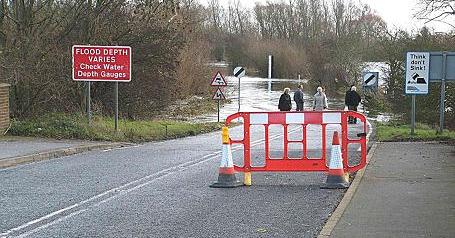
The signs are not very helpful
and the barrier totally innefective.
and the depth boards are a log way off
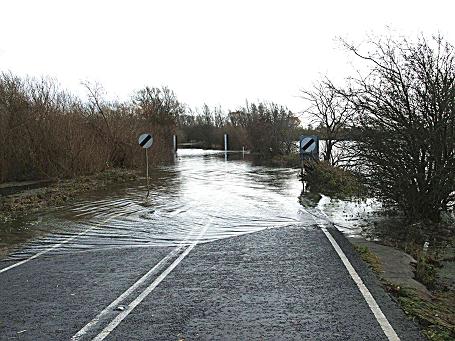
clck photos for larger views
(photos above courtesy Mark Farrow)
Below, more than three months later
photo by Chris France 13th March 2007
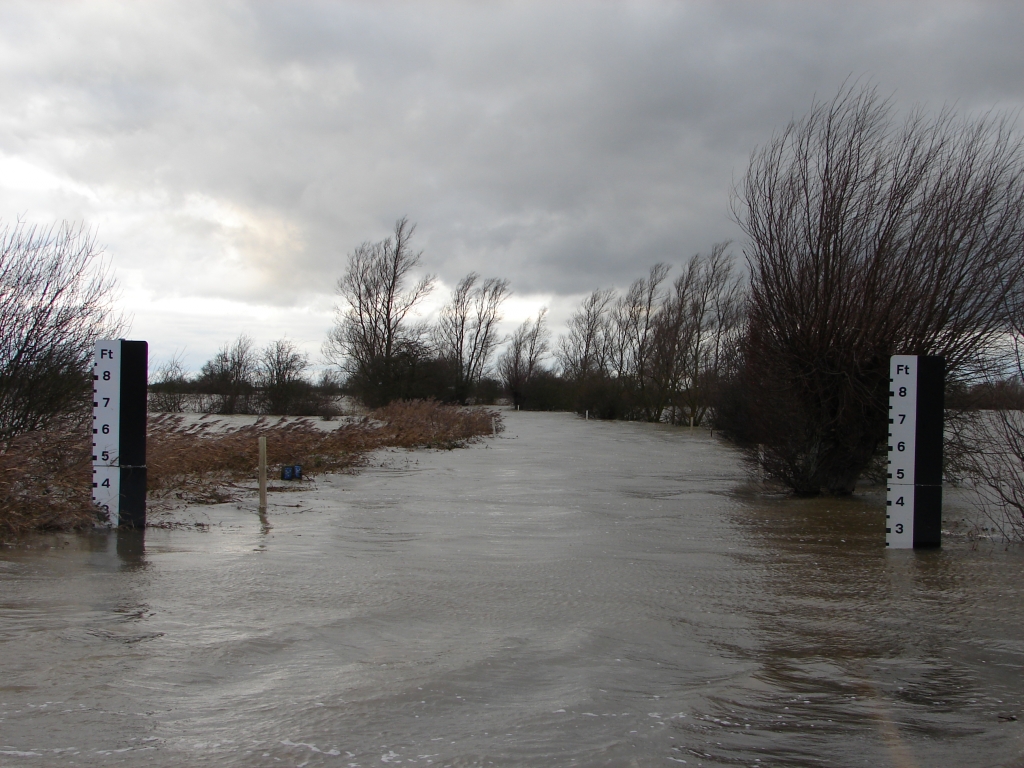
| Welney Parish Council |
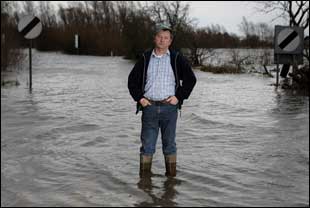
WPC Chairman, Cllr Ken Goodger
(photo by Matthew Usher)
click photo for a close-up of Ken
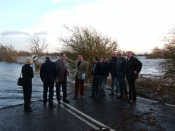
Borough & Parish Councillors meet on site
(photos courtesy Cambs Times)
Council Chairman Ken Goodger has waded into the flood problem personally, spearheading an action group. He said "The tidal river, the Ouse, is silted up and has not had the work done on it that it used to get years ago." He explained that the average flooding depth on the A1101 was 18 inches and that raising the road just one foot would avoid many of the flooding problems. "I think everybody affected would like to see the road raised," he said. "We are a modern community and should not have to put up with it. For us it is not a case of what could be done, but when it can be done."
"The EA told us Welmore sluice [situated at end of the River Delph to drain the Washes into the river] is working, but it can't work when the river is full of silt. When you ride over the bridges at Downham, Stowbridge and St. Germans, look at all the silt that's in the river. There's no way they're going to get the water off the washes when it's silted up like that. When they can't get the water off, the road floods. If they could only just raise it 15 or 16 inches it would make a lot of difference".
Parish councillors also asked the MP for SW Norfolk, Mr. Christopher Fraser, to raise the issue with Government. Mr Fraser said after meeting Cllr. Goodger, "There is no doubt that this is already a very serious problem that potentially could get much worse if it is not addressed as a matter of urgency. The root of the problem seems to be the silting up of Wellmore Sluice and Denver Sluice. Dredging has not been carried out for some time, and the silt has solidified so that the flow of water, even in time of flood, is not sufficiently strong to wash the silt through. It is time that the government and the Environment Agency realised that they cannot ignore the problems of the fens on the basis that it would cost too much to resolve."
The Parish Council clerk, Mrs Pat Copeman, said: "Motorists who do not read warning signs about the flooding were causing additional problems. They see they cannot get across and then struggle to turn around because the road is so narrow, the big problem has been the lorries, with some forced to turn around in the car park of the Lamb and Flag."
| Lamb & Flag Inn |

Gina Webb & Dennis Birch
(photo courtesy Cambs Times)
Despite the floods the pub is set to be open every day over the festive period, with food served every day except Christmas Day. But Mr Birch's partner, the pub's landlady Georgina Webb, said: "We do not approach it any differently because you have got to be ready for your customers. But the first thing we have to do is lay off staff because we have not got the money coming in to pay them."
Mr Birch claimed the problems have been caused by poor management in de-silting the river, and by homes being built on flood plains. "If people keep doing this it will get worse," adding that low oxygen levels in the river, caused by the silt build-up, was killing fish.
| Village School |
| Welney Stores and Post Office |
Mr Redman said the EA had been slow to react to the problem of silt in the tidal river between St German's and Welmore sluice. "When they built the sluice in 2000 they were aware of the tidal river silting up, but they still put doors in, instead of pumping the water which would have moved it."
He also accused the agency of not doing anything until there is an emergency. "When the road first flooded [in November] the Environment Agency could not get the sluice doors open at Welmore. The water had been on the road almost a week before the doors were operative and was [by then] at least two feet deep." He warned that problems would get worse for village businesses and that house prices would be affected until the agency faces up to the fact the River Delph must be dredged.
| Environment Agency (EA) |
In January 2007 the EA announced that repairs to Denver Sluice [downstream from Welmore Sluice] are included in a £19million package of flood defence measures. The massive gates have become so silted that they cannot be opened to allow water from the Ouse to run off through the tidal river course, which became silted up as river flows were diverted via the relief channel. The sluice would be dammed off and the gates cleared of silt for inspection, to see if modifications could be made to stop them silting up in future. The inspection would establish if the doors could be replaced and the plan would be to install some form of mechanism to get rid of the silt.
Nigel Wooton, the EA's area flood risk manager, said "The problem of silt in the tidal river is a much bigger problem and we have a study being funded next year [2008] to look at the issue of silt and how we might deal with the problem. Dredging the silt is not the answer."
Webmaster's note: After hundreds of years of recorded siltation problems in our sluggish fen rivers, one would have thought the EA would already know the answers, and would be spending our money on remedial action rather than paying consultants for yet another expensive survey.
| Claire Freer resident of Suspension Bridge, Welney. Letter in Cambs Times, Jan 2007 |
I am a governor of the school and have had to miss two meetings already because of the flooded road and will be missing a full governors' meeting again next week. The cost of this avoidable disruption to me personally is £120 a month in terms of fuel. I have not calculated the cost of my time or the wear and tear on the car. I would like to know if there is anyway of reclaiming this additional cost.
I would also like to know why the road was miraculously clear the two weeks of the Christmas break. I knew about the road when I moved here but in the last four years there has been negligible disruption. I would like some answers not excuses."
| Trevor Bevis Fens historian and author of March, letter in Cambs Times, Jan 2007 |
The road has always been recognised as a causeway subjected to flooding at certain times of the year. To elevate it would necessitate the construction of several culverts and would cost millions. Efficient management of sluices, at Denver for instance, certainly comes into question. Silt is always a problem affecting sluice gates and watercourses. As far as the Fens are concerned silt can jeopardise efficiency well inland.
More than three centuries ago the Bedford Level Corporation drew up rules for sluice keepers operating and maintaining Denver sluice, Salter's Lode sluice and the Old Bedford River sluice (1631) contiguous to the tidal river "and requiring constant care." Sluice keepers have always been regarded as indispensable experts in the unrelenting struggle to prevent the Fens from reverting to their former state.
In our own day and age it is becoming necessarily expedient to economise. Certainly this affects maintenance and staffing. Costs escalate and modern-day guardians of the Fens with licence to exercise powers over three great Levels have to balance expeditious planning with income and expenditure. There is no easy answer.
Seeing what has happened in the country in the past few weeks through the devastating onslaught of gale-force winds and torrential downpours serves to remind those of us residing in the Fens how very fortunate we are to live in an area served by the most efficient drainage system in the country, on equal par at least to the Netherlands. By rights we should be up to our necks in water. The costs of keeping the fields and our feet dry must be enormous, almost prohibitive.
I believe the drainage commissioners do a good job, yet regarding Welney's existing problem and bearing in mind the rational attitude embodied long ago in the Bedford Level Commissioner's directive, at the forefront of our reasoning can we expect more of the current drainage commissioners? Does consistent silting against the sluices and the dire effect it is having inland deserve greater remedial action?
| Webmaster |
| "Fenland Citizen" online report, 23rd Jan 2006 |
The man – believed to be in his 40s and from Norfolk – had driven from the Littleport direction to Welney before his car became submerged. When the crew spotted him, after being alerted at around 9.15am on Sunday, he was "waist deep in water and hanging from a tree". "He looked like he needed immediate evacuation," said Flt Lieut Ball. Winchman Sgt Paul Hunter dropped some 70 feet to bring the man back to the helicopter with the aid of a special harness. He was very cold and treated in the helicopter while it made the eight-minute journey to the Queen Elizabeth Hospital at King's Lynn where the man, thought to be suffering from hypothermia, is being treated.
It is thought he had been trapped by rising flood water for around six hours. "He was certainly pleased to see us," Flt Lieut Ball added. Cambs Fire and Rescue Service and Norfolk fire service attended the scene after anglers heard cries for help. A loud hailer was used to communicate with the man and faint cries were heard. The coastguard and the RAF were then alerted as they were unable to reach him. "He is lucky to be alive," said Yarmouth coastguard watch manager Peter Wheeler.
| Paul Grodkiewicz Lock-keeper at Salters Lode Letter in the Cambs Times online edition, 26th January 2007 |
The whole system relies on the River Great Ouse to carry flood water safely to sea at low tide, but the river has silted to a level which now endangers all in this area. Due mainly to neglect, the Bedford Levels are unable to drain efficiently through Welmore Lake Sluice, causing, among other complications, the causeway into Welney to remain flooded for weeks or months at a time.
The Old Bedford Sluice at Salters Lode is sealed shut by hundreds of tons of silt and is completely inoperable.
The sluice gates at Denver are likewise sealed shut, putting Ely at great risk, even though a dredging machine has been on site since about February 2006.
The massive sluice gates at Lynn, at the head of the Relief Channel, our last line of defence, are hardly in any better state. There are acres of silt build-up. This, coupled with mechanical problems, puts us in peril.
The Environment Agency is entirely unable to look after our safety in this matter. This is due, in my opinion, to a complicated mix of neglect, ignorance, arrogance, inter-departmental squabbling and over-reliance on computers. A concerted dredging campaign needs to be instigated immediately, but won't be, and there is nothing we can do about it except die in the flood while they argue.
The right combination of weather systems and bad luck is building against us. The flooding of the fens is a certainty. The only unknown is how many bodies will be floating in the water."
| "Cambs Times" report by Tom Jackson 23rd Feb 2007 [with comments added by Webmaster] |
For on the day the Environment Agency took their roadshow [to] the Welney Wetland Centre to explain how the Fens faces a greater risk of flooding over the next 50 to 100 years, in Welney itself the harsh realities of flooding were continuing to be driven home. For more than two months - apart from a brief respite - the village has been marooned after flooding along the A1101 on the Welney Washes has made the village impassable for traffic heading from Wisbech to Littleport.
And it has always led to local businesses losing trade, commuters having to drive hundreds of miles extra each week to get to work, and children facing difficulties in getting [to school]. The Wetlands Trust pointed out to visitors that access was still possible - but from the A10 through Ten Mile Bank, which means for all intents and purposes a trip too far for most villagers. Motorists who have ignored the warning signs not to drive along the A1101 have ended up stranded on the Washes - with some motorists having to be rescued by the emergency services.
Meanwhile for those who did attend the Environment Agency presentation, there was a stark reminder of how climate change, increased urban development and land use will increase the risk of flooding over the coming years. The agency is recommending further flood defence work is undertaken in the areas most at risk.
Residents and businesses are being called on to help shape the Great Ouse Catchment Flood Management Plan as part of public consultation that will run until the end of March. The report comes almost 60 years after the Great Ouse, Welland and Nene rivers burst their banks after a winter thaw and heavy rain, which caused 6ft deep floods across vast areas of the Fens.
The agency says that more than 33,000 people and 16,000 properties would be at risk in the event of a flood of a "one-in-100 years" magnitude. Lucy Harper, from the Environment Agency, said: "We are running into the realm of flood risk management rather than flood defence and focusing on the best places to spend money to achieve maximum benefits for the maximum number of people".
It was also this week that [it was announced that] a major nature reserve could be created to replace parts of the Welney Washes which persistent flooding has rendered unsuitable for nesting birds. There has been a decline in the amount of wet grassland habitat for birds such as the snipe, black-tailed godwit and wigeon.
| "Cambs Times" online edition report, 2nd March 2007 |
As reported in the Cambs Times and Wisbech Standard, water on the Ouse Washes flood plain has risen to cover the A1101, which connects the village with the rest of Norfolk leaving it impassable for most vehicles. Some parents have been left with a 40-mile round trip diversion just to take their children to school, while the floods are affecting trade at Welney's last remaining pub and shop.
Mr Fraser has already met with members of the parish council and he pledged to do all he can to help the villagers. He said last night: "For more than two months A1101 has been under 2-3ft of water. "The waters may recede for a few days, but every time we have constant steady rain, as in the last few days, they return. "Constituents whose homes businesses and daily routes have been affected are desperate for a solution."
He added: "It is time that the government and Environment Agency realised that they cannot ignore the problems of the Norfolk fens. Ministers must now support the local councils, whose financial support has already been cut to the bone and step in with a rescue plan. This is a national problem not a local one, but yet again Norfolk finds itself at the wrong end of the Government's priority list."
While the Environment Agency plans to repair sluices on the River Ouse at Denver a few miles downstream the parish council believes raising the road is the only answer. The council has written to a number of departments and organisations calling for help and is also trying to get a coalition of villages to act together in raising the issue, as it is not just Welney which has been affected.
| Webmaster's comments on EA budget cuts posted 4th March 2007 |
The cuts were needed because the new farm payments scheme in 2006 was so badly administered that the number of claimants doubled, the IT system failed to cope and hundreds of extra staff had to be hired. In the days when farming had a government department of its own, MAFF, the extra costs would have been met from within that dept or from general contingency funds. But now it is part of the huge 'super-ministry', DEFRA, the Secretary of State can simply lop chunks of money from all the diverse parts of his realm, from the Welsh Assembly to British Waterways and the Environment Agency.
When I posted this comment on 4th March 2007 I noted that "the Wash road has been flooded for most of this winter, and today to a depth of 50cm, or 20 inches, and it is raining again so things are likely to get worse. River beds and sluices are apparently silted up all over the Ouse Washes area due (allegedly) to lack of maintenance, and climate change is beginning to have an effect".
So what does the Government do? Well, our local MP was told in reply to his question in the Commons (see above), it was really nothing to do with them, try his luck with the EA. But the EA have had their budget cut because of bungled farm payments, described by the National Audit Office as a chronicle of government incompetence, by £24m in all, of which £15 million is to be from flood management. So there is even more excuse now for the EA to avoid remedial action, even if they wanted to do so, which from their comments so far does not seem to be the case.
|
Acknowledgements. Layout © Peter Cox, 2006-11 Reports and letters first published in Cambs Times, Cambs 24 online, and Fenland Citizen on-line. If you think this report is incorrect, incomplete or unfair, please e-mail the webmaster, and your response will be added. |
| Related pages on this website |
| Fens Rivers and washes overview |
| Wash Road flooding overview |
| Floods 2009 |
| the EA view |
| the RSPB view |
| the WWT View |
| A question in the House |
| Police issue fines - then do a U-turn |
| Related pages on external websites |
| Welmore Lake Sluice |